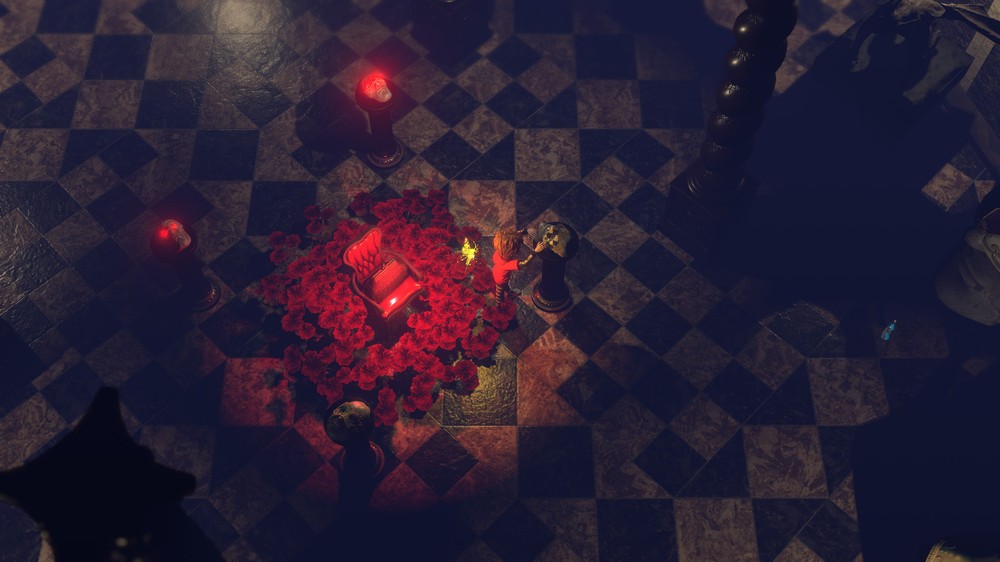Reality is relentless. Heartbreak, disappointment, and isolation, drive people to look for a little light in the world in the form of a distraction. In Nightmares is an isometric, narrative-driven horror adventure where dreams and reality are indistinguishable. It’s a nightmare fueled hellscape, with puzzles, collectibles, and boogeymen lurking around every corner. While it does an amazing job of being creepy and feeling dreamlike, the puzzles and story are less than engaging and are more likely to drive you to look for a different distraction.
Players step into the shoes of William, a young boy looking for love in all the wrong places, his nightmares. The six chapters take William through haunted mansions, decrepit schools, and spooky parks, looking for some light, only to be met with more darkness. The world design and characters carry a whimsical feeling that evoke the likes of Little Nightmares and Coraline. It’s done well and works great in conjunction with little horror details spread throughout the world, such as a deadly playroom or a portrait of a babadook hung throughout a level. Each level stands out with some unique flavor of creepiness. The aforementioned mansion has a portion where you hide from onlookers peeking through each window. A carnival section has you roaming through a maze-like tent, avoiding boobytrapped rooms. If you’re looking for horror or are just looking to be creeped out, there is plenty of that to be had here.

What In Nightmare contains in style, it lacks in substance. William’s goal (to find love) is not strongly defined. There’s no indication of what exactly it is you are looking for. Most objectives given throughout the campaign fall into the categories of “solve puzzle” or “escape.” There are random item pickups that trigger memories from the real world. These memories put William’s broken home on display, but only hint at some of his homelife issues. There are also notes peppered around the levels that should shed more light, but these are so on the nose, it’s hard to take them seriously or attach any emotional weight to them.
One standout example is a note written to “Mr Principle” that details some issues William is having at school with the other children. I’m not being flip or paraphrasing, that is the content of the letter. There are some other examples where letters are poorly translated. It’s an unfortunate circumstance. William’s nightmares give us a glimpse into how he perceives his reality. These notes paired with the memories and the nightmares are supposed to paint a clearer picture of William’s life. Instead, they muddy the lines between the two worlds and make it hard to care about either.

As William, you’ll solve puzzles, find collectibles, and run from the nightmarish monsters trying to hunt you down. The angled camera can make navigating some areas tricky, especially when you’re in the middle of a heated chase sequence and find yourself trapped in a corner. The game provides a semi-solution to this issue in the form of Bikti, your butterfly companion. Using the right thumbstick, Bikti can move ahead of you to scout an area. This is great for looking for collectibles and getting an idea of where an enemy is at, but the short range really limits the functionality, even with the ability to extend the range through pickups. Bikti’s ability becomes less useful during the frantic chase scenes. Scouting ahead and running for your life do not blend well, and often end in you cornering yourself or falling into a trap.
There are gobs and gobs of collectibles scattered throughout In Nightmare’s campaign. These vary from concept art to pieces of the game’s soundtrack. You’ll find these along your path and hidden in secret areas, the latter of which you can track down using one of Bikti’s abilities. Collectibles can be accessed in a central hub area which is a nice break from all the puzzling and running for your life. There are also collectable upgrades for William’s health and stamina as well as Bikti’s abilities. While the variety in pick-ups are nice, I didn’t feel the upgrades to William, or his companion were completely necessary. I never found myself low on health or needing the sprint to last just a little longer. Bikti’s abilities are tied to resource bars, but the game supplied enough resource replenishers to the point where I felt the upgrades to those resource bars were useless. Adding to that, it’s hard to track exactly what pick-ups you’ve collected in each level. There appears to be no menu for tracking this and backtracking seems almost impossible without some kind of map menu in the game.

There are a few puzzles across In Nightmare that I appreciated in my time with the game. One standout is a particular moment in the fourth level. William comes to a painting that is missing three pieces. To find these pieces, players will have to explore each corner of this elaborate mansion, dodging shadows, poisonous gas, and the gaze of looming figures. While there are some great puzzles, many are just middling, with a good amount of them being a blend of fetching, switch flipping, and stealth. This blend grows stale pretty quickly. Level four contains three separate areas where you must avoid the enemy characters, while flipping switches throughout a huge room. Once is enough, three feels like you’re trying to pad out a level. There are also a few headscratchers along the way. One puzzle has you use part of the environment to crush a nearby enemy. Following that, you’re then required to find your way around.another obstacle. The solution presented itself (literally) with no how or why about it, the solution just appeared out of thin air. That’s not to say all the headscratchers are bad. There are some really good puzzles here that require some thinking, especially in the puzzle heavy third level.
Speaking of headscratchers, there are some platforming areas throughout the campaign. Jumping and minding gaps in isometric games is already a tough sell. It’s even harder to sell in a game that features chase scenes. It’s just an annoying addition that takes away from the thrill of the chases. To my surprise, In Nightmare does feature a few boss fights. These add a little more variety but do come off more as puzzles and less as bosses. These encounters involve avoiding the enemy while completing some sort of tasks to set up a trap. While these encounters can come off as repetitive, it is nice to fight back after multiple levels of being chased.

In Nightmare does an amazing job of scaring the pants off of you and capturing the whimsical nightmare aesthetic it sets out for. It’s filled with puzzles, and while not all of them hit, there are some great brain ticklers spread throughout the game. The chases, while at first scary, quickly become a chore stuffed in-between puzzles. All of that along with a narrative lacking emotional pull, make In Nightmare a short distraction that will leave players looking for another distraction.











